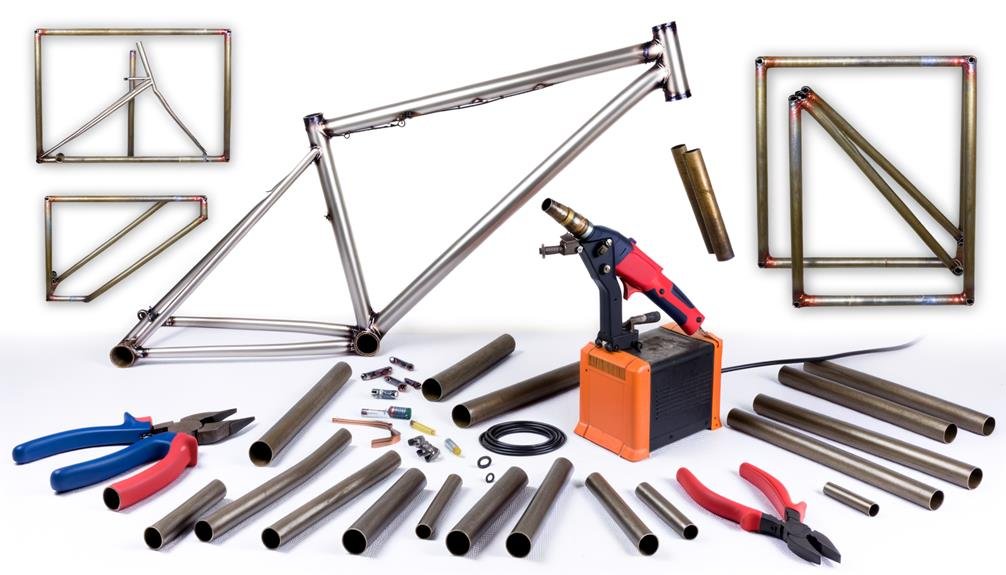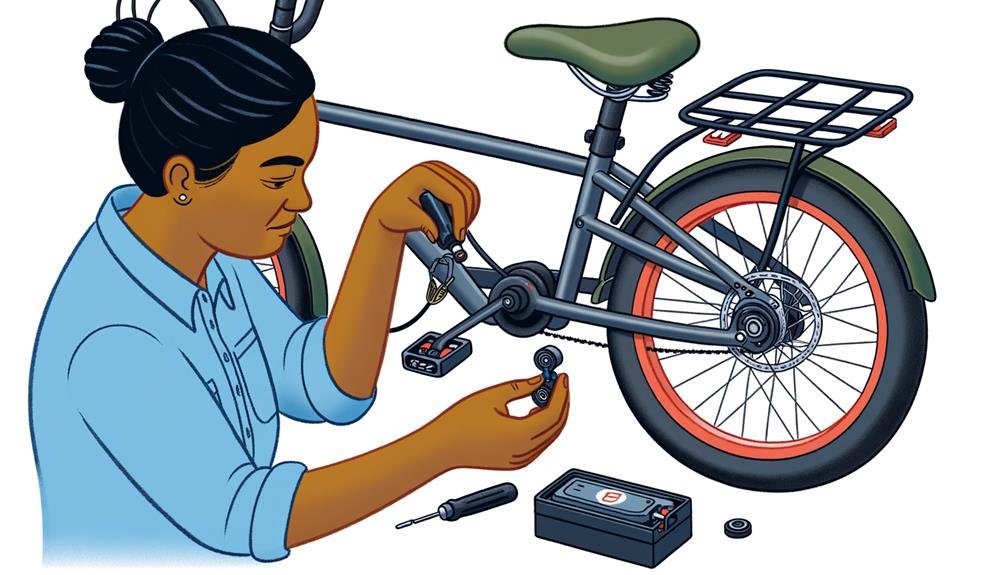Charles Miller is a veteran bike enthusiast with over 12 years of experience dealing with bikes as a mechanic. Despite immense love and expertise for...
Beneath the sleek and shiny surface of your electric bike lies a labyrinth of complex components, each playing a pivotal part in propelling you on your journey.
I've spent years studying, scrutinizing, and sometimes even disassembling these fascinating machines to fully grasp their inner workings.
From the all-important battery, the heart of an e-bike, to the cleverly concealed motor and the feather-light frame, the creation of electric bikes is a process steeped in innovation and engineering excellence.
However, the process of creation doesn't stop with just parts and pieces, there's a whole world of wonder to uncover.
So, are you ready to embark on this electrifying expedition?
Key Takeaways
- Electric bikes consist of key components such as battery packs, electric motors, frames, and brakes, all designed to work together for efficient and smooth rides.
- During the design and planning stage, considerations are made for motor types, performance optimization, battery pack integration, control systems, and braking systems.
- Frame construction techniques include aluminum alloy frames crafted through welding and bonding, hydroforming for robust and lightweight frames, and carbon fiber frames for a lighter and easier to handle bike.
- The motor integration process involves hand assembly, controller assembly, electrical testing, gear insertion, stress testing, and quality control to ensure optimal performance and product safety.
- Battery and sensor installation involves positioning the battery low and centered for balance, understanding the battery's specifications, installing sensors to monitor speed and torque, and considering power needs and battery life for optimal e-bike performance.
Understanding Electric Bike Components
Let's take a closer look at the key components of electric bikes, which include batteries, motors, frames, and brakes, all designed to work together for efficient and smooth rides.
The heart of an electric bike is the battery pack, typically lightweight lithium batteries. They store the power needed to propel the bike and provide around 350-500 watts of power output.
The electric motors, often built into the hub of either the rear or front wheel, are the muscle of the bike. They draw power from the battery pack to supply the necessary torque, turning the wheels and moving you forward. When the motor is in the rear wheel hub, you'll feel a push. If it's in the front hub, it'll feel more like a pull.
The frame, generally made of lightweight aluminum alloy, along with stronger wheel spokes, ensures your electric bike can handle the motor's torque. This provides stability and durability when you need it most.
The Design and Planning Stage
Diving into the design and planning stage of electric bike production, engineers meticulously determine the specifications for the batteries, motor, frame, and brakes. As a stakeholder in this process, it's fascinating to delve into how different models of electric bikes are created across various bike brands.
The first major decision involves choosing the type of electric motors. There are two main types:
- Hub motors are placed in the center of the bike wheel, offering a balance of power and simplicity.
- Some motors are made to be integrated into the bike's frame as mid-drive motors, providing superior balance and handling.
The next crucial aspect is the design of the electric bicycle itself.
- To optimize performance, engineers consider factors like weight, balance, and aerodynamics.
- The integration of the battery pack into the frame and positioning of control systems are also carefully planned for an optimal user experience.
Lastly, the planning stage includes mapping out the bike's braking system.
- Engineers must design brakes that can handle the additional power and speed of electric bikes.
This process is vital to delivering the high-quality, efficient, and user-friendly electric bikes we enjoy today.
Frame Construction Techniques

Now, we're onto the frame construction techniques, a critical phase that shapes the durability and stability of electric bikes. These methods are the backbone of all electric bicycles, providing the structural integrity that keeps us safe on the road.
Electric bikes often have frames crafted from aluminum alloy through welding and bonding techniques. These frames house the electric motors and ebike batteries, which are made from cells. Some manufacturers, like Rad Power, use a high-pressure fluid technique, known as hydroforming, to shape the metal. It's an environmentally friendly option and delivers a robust, lightweight frame that doesn't compromise on product safety.
For those of you seeking a top-tier experience, look out for electric bikes with carbon fiber frames. These frames are incredibly light but strong, crafted to withstand the power generated by the motors. They're the choice for high-end electric bikes, supporting the weight of the bike and rider while making it easier to handle the bike.
Motor Integration Process
Moving on to the motor integration process, it's fascinating to note that Bafang, a prominent motor manufacturer in Suzhou, China, employs a meticulous hand assembly method for its core components. It's a blend of human precision and robotic efficiency that gives each motor the extra push to perform exceptionally.
This process isn't as simple as it sounds, and involves multiple stages:
- Hand assembly of the core components, including 39 delicate magnets and copper wire placement around stators.
- Assembly of the controller in a clean room for maximum precision and to prevent contamination.
- Electrical testing and gear insertion to ensure the perfect balance of speed and torque.
Once assembled, each motor undergoes rigorous stress testing simulating real-world conditions, and dynamometer testing to measure power output and performance. Only the motors that pass receive a coveted QC-Passed sticker, a unique serial code laser engraved for easy identification and tracking.
But what gives these motors their much-needed power? The answer lies in battery packs. Higher voltage equates to more power, and Bafang ensures the battery voltage is optimized for every motor. This attention to detail extends to every aspect of the motor integration process, reflecting their commitment to quality.
Battery and Sensor Installation

Having thoroughly explored the motor integration process, let's shift our focus to another crucial aspect of electric bike manufacturing – the battery and sensor installation.
When it comes to the battery, it's all about the balance of power. The battery is positioned low and centered to maintain balance on the bike. Understanding how much power you need, how frequently you'll need to recharge, and the factors that affect battery life are key to making the most of your e-bike.
The wattage, voltage, and amp-hours of the battery determine its capability and duration. With higher voltage, you'll get better performance, while more amp-hours will give you a longer-lasting battery. This is what you need to know when considering your e-bike's power needs.
As for sensors, those are our bike's little detectives that monitor speed and torque to determine when to kick the motor back onto action. Last year, at the Bafang factory in Suzhou, China, I observed the meticulous process of sensor installation, ensuring the bike's motor responds perfectly to your pedaling efforts.
Frequently Asked Questions
How Electric Bikes Are Manufactured?
I assemble electric bikes by combining a motor, battery, frame, and brakes. Most of these parts come from Asia, but I do use some high-end components from the US and Europe to ensure quality.
How to Make a Electric Bike?
I'd start by acquiring a bike and an electric bike kit. Then, I'd attach the motor to the bike frame, connect it to the wheel, and install the battery and controller. It's a fun DIY project!
What Is the Difference Between an E-Bike and an Electric Bike?
Actually, there's no difference between an e-bike and an electric bike. They're both the same thing! They use a motor to assist with pedaling and can even propel themselves depending on their setup.
How Is an Electric Bike Powered?
As an electric bike user, I power my bike with a motor and battery. The motor kicks in when I'm pedaling to provide assistance, making my ride easier. This is all monitored by sensors on the bike.
Conclusion
Building bikes brimming with brilliance isn't basic. The process is packed with precision, from the carefully crafted frames to the fitting of feisty motors.
The installation of intelligent batteries and sensors is an integral part of the process. It's a fascinating feat of engineering, how these elements elegantly entwine, creating an efficient and eco-friendly e-bike.
So, the next time you're on an e-bike, remember the meticulous manufacturing that went into making your ride remarkable.

Charles Miller is a veteran bike enthusiast with over 12 years of experience dealing with bikes as a mechanic. Despite immense love and expertise for his Tacoma, he rides his Trek Ebike more. Anytime you meet him, you’ll either hear him talking about Bikes, or writing about all things bikes and cars on this blog.
More Posts


